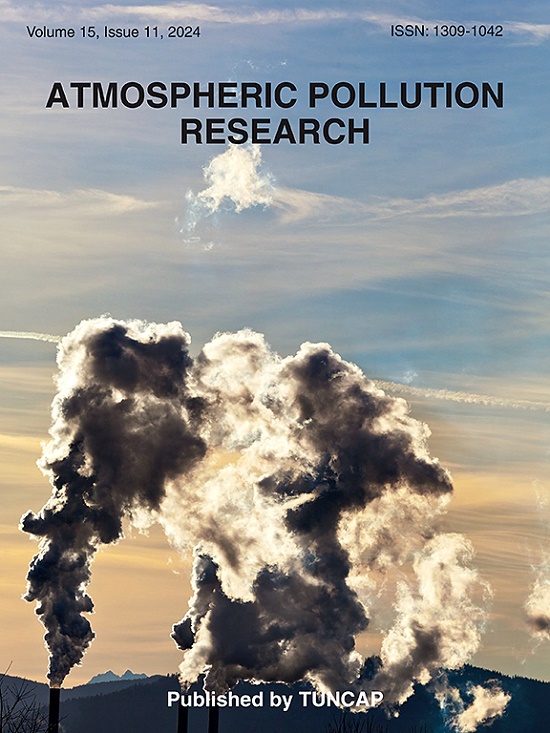围孕期空气污染和气候参数暴露与土耳其后代尿道下裂风险之间的关系:一项病例对照研究
IF 3.5
3区 环境科学与生态学
Q2 ENVIRONMENTAL SCIENCES
引用次数: 0
摘要
我们的目的是调查在孕前和孕后期间尿道下裂与接触空气污染物和气候参数之间的关系。本研究是一项多中心病例对照研究,涉及340名0-3岁的尿道下裂儿童和357名同龄的申请包皮环切术的儿童。共获得7种大气污染物(PM2.5、PM10、NO、NO2、SO2、CO、O3)和5种气候参数(气温、相对湿度、气压、风速、降水量)数据。在多因素logistic回归分析中,较年轻的母亲年龄(参考:35岁)和母亲吸烟(参考:无暴露)与尿道下裂的可能性较高显著相关。相反,怀孕期间补充叶酸(参考文献:不补充)和母亲BMI在25 - 30(参考文献:<;25)范围内与其发生的可能性较低相关。在调整了儿童家庭特征后,CO、平均温度、最低温度、RH和AP的四分位数范围(IQR)的增加与尿道下裂呈正相关,而SO2水平和日温度范围(DTR)呈负相关。个体因素和环境因素的综合分析进一步强调,母亲年龄较小、吸烟暴露、PM10和气压与尿道下裂呈正相关,而较大的DTR与尿道下裂呈负相关。较年轻的母亲年龄、吸烟暴露、特定的空气污染物(如PM10和CO)以及气候因素(如AP)与尿道下裂呈正相关。这些发现强调了减轻环境暴露和促进孕产妇保健干预以降低尿道下裂等先天性异常风险的重要性。进一步的纵向研究是必要的,以证实这些关联和探索潜在的机制。本文章由计算机程序翻译,如有差异,请以英文原文为准。
Association between air pollution and climate parameters exposure during the periconceptional period and hypospadias risk in Turkish offspring: A case-control study
We aimed to investigate the associations between hypospadias and contact to air pollutants and climate parameters during the pre- and post-conceptional periods. This study has been carried out as a multicentre case-control study involving 340 children with hypospadias between the ages of 0–3 years and 357 children in the same age range who applied for circumcision. A total of 7 air pollutant (PM2.5, PM10, NO, NO2, SO2, CO, O3), 5 climate parameters [air temperature, relative humidity (RH), air pressure (AP), wind speed (WS) and precipitation amounts data were obtained. In the multivariate logistic regression analysis, younger maternal age (reference: >35 years) and maternal smoking (reference: no exposure) were significantly associated with a higher likelihood of hypospadias. Conversely, folic acid supplementation intake during pregnancy (reference: no supplementation) and maternal BMI in the range of 25–30 (reference: <25) were associated with a lower likelihood of its occurrence. After adjusting for child-family characteristics, increased interquartile ranges (IQR) of CO, mean temperature, minimum temperature, RH, and AP were positively associated with hypospadias, whereas SO2 levels and diurnal temperature range (DTR) were inversely associated. Comprehensive analysis of individual and environmental factors further highlighted that younger maternal age, smoking exposure, PM10, and air pressure were positively associated with hypospadias, while a greater DTR was inversely associated. Younger maternal age, smoking exposure, and specific air pollutants, such as PM10 and CO, as well as climatic factors like AP, were positively associated with hypospadias. These findings underscore the importance of mitigating environmental exposures and promoting maternal health interventions to reduce the risk of congenital anomalies like hypospadias. Further longitudinal studies are warranted to confirm these associations and explore underlying mechanisms.
求助全文
通过发布文献求助,成功后即可免费获取论文全文。
去求助
来源期刊

Atmospheric Pollution Research
ENVIRONMENTAL SCIENCES-
CiteScore
8.30
自引率
6.70%
发文量
256
审稿时长
36 days
期刊介绍:
Atmospheric Pollution Research (APR) is an international journal designed for the publication of articles on air pollution. Papers should present novel experimental results, theory and modeling of air pollution on local, regional, or global scales. Areas covered are research on inorganic, organic, and persistent organic air pollutants, air quality monitoring, air quality management, atmospheric dispersion and transport, air-surface (soil, water, and vegetation) exchange of pollutants, dry and wet deposition, indoor air quality, exposure assessment, health effects, satellite measurements, natural emissions, atmospheric chemistry, greenhouse gases, and effects on climate change.
 求助内容:
求助内容: 应助结果提醒方式:
应助结果提醒方式:


